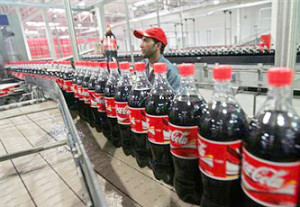
The Court ruled that the five-fold increase in groundwater withdrawals, requested by the company will aggravate the water supply situation even further, which has significantly deteriorated since the arrival of Coca-Cola in India in 1999.
Back in 2009, the local authorities of Mehdiganj (the area of Varanasi being part of it) were forced to impose restrictions for peasants to use the ground waters, which could not but entail their negative response, aimed at the largest American corporation. The situation was aggravated by the fact that 70% of the water withdrawal accounts for the period from March till June, when the level of the groundwater occurrence reaches its minimum, which restricts the possibility of it being used by the locals, living at the expense of agriculture.
One Coca-Cola enterprise only uses one million liters per day. However, the production of the final product (600 bottles per minute) requires a quarter of the withdrawn ground water volume. A large part of it becomes waste which is discharged, without a full cycle of purification, into the environment and reaching the fields and water reservoirs, causing their contamination. State ecological authorities of India took samples of the waste produced by nine Coca-Cola factories and found a very high content of lead, cadmium and chromium, exceeding the safe standards for the health of the population by 30 times, which can result in the immune system malfunctions and presents a danger for cancer occurrence. One cannot say the same about the Coca-Cola drinks sold in the USA. There, according to conclusions made by the Indian non-government organisation ‘Centre for Science and Environment’, no poisonous substances were found in the company’s products. The Indian parliament has even prohibited the sale of Coca-Cola drinks in the building of the legislation authority, due to the high content of pesticides and chemicals, including DDT.
Another problem for Coca-Cola became the territorial aspect. Business expansion requires new areas, part of which is in the ownership of the communities, and the private usage of which is prohibited by Indian law. At the end of 2013, the Mehdiganj local authorities issued an order which envisaged evicting Coca-Cola from the territories unlawfully taken by it. Earlier the Supreme Court of India ruled in favour of banning the placement of any structures into the communal properties. Therefore the instruction of the local authorities on demolishing the Coca-Cola factory does have legal grounds.
The loss of the project worth 25 million dollars is a great financial fiasco for Coca-Cola, which considers India to be one of the major sale markets (among 200 countries where its products are being sold), generating high profits, which have significantly decreased in developed countries. This is due to the fact that people there are becoming increasingly concerned about their health and the consumption of Coca-Cola products presents a serious threat to it. Coca-Cola, which is considered to be the largest foreign investor in India (2 billion dollars from 1993 up to 2011), is planning to invest 5 billion dollars by 2020, into the development of its business in the country. And all of this is happening despite the growing discontent of the population, legal costs, and disputes with local authorities. Now the company has to improve its ecological image by trying to convince the Indian population that it does not have to do anything with water contamination or its shortages.
However, the statements of the company have not reassured Indian society; neither have the attempts of Coca-Cola to expand its charity activity in India. The population is protesting against the American company in different ways every day. According to Amit Srivastava, head of India Resource Center, R&D institution, which is taking an active part in arranging the protest campaign, “Coca-Cola’ is a shameless and non-ethical company, which places receiving its profit above the well-being of the communities, existing in proximity to its enterprises”. Nandlal Master, a representative of another non-governmental structure, campaigning for the closure of the factory, admits: “The local community has achieved a great victory and it has proven that it is possible to destabilize the authority of a large business”.
Natalia Rogozhina, PhD in Political Science, Head Research, Institute of World Economy and International Relations, Russian Academy of Sciences, exclusively for the online magazine “New Eastern Outlook”.
